Disclaimer: This website contains affiliate links, from which Heritage Acres Market LLC may receive a small commission from the vendor on the sales of certain items, all at no cost to you. Please read our full disclosure for more information. Thank you for supporting Heritage Acres Market LLC!
There are less than 20 species of true Button quail worldwide. Because they are small ground-dwelling birds that rarely fly, they are challenging to spot. Exact numbers for each type are hard to judge and frequently remain unknown, but many are rare or endangered.
Button Quails kept in the US as ornamental birds are not true Buttonquails, but have been called this due to their small size.
Button Quail (Coturnix Chinensis, formerly Excalfactoria chinensis) goes by several other names, including Chinese Blue Painted Quail, Chinese Painted Quail, Painted Button Quail, King Quail, or the Blue Breasted Quail. They are not, in fact, true Buttonquail, which belongs to the genus Turnix or Ortyxelos.
These Button Quail should not be confused with Coturnix Quail, which is a different breed of quail.
Is the Button Quail right for you?
- Button quail are very shy and can be difficult to tame if they are not hand-reared
- They are not suitable as pet quail for children as they are delicate and don’t like being handled
- Button quail are relatively hardy once acclimatized require little by way of special care
Table of Contents
Background and History
Button quail and Buttonquail are tiny secretive ground-dwelling birds that are exceedingly hard to spot in the wild. This means that little is known about them, and scientific data is minimal.
Interestingly the sexual roles in some Button Quail species are reversed to that typically observed in most other birds. The females have the most brightly colored feathers, lead courtship, and guard territory. Some are also polyandrous, moving from mate to mate and allowing the males to set eggs and raise young. In other types, it is the female who broods the eggs while the male stands guard.
The naming of button quail species is somewhat confusing, with many having more than one name depending on where they are found. They inhabit Spain, sub-Saharan Africa, the northwest African coast, Madagascar, New Guinea, south and southeast Asia, the Solomon Islands, and Australia.
The conservation status of many Buttonquail species is not exact as the birds are exceedingly difficult to observe in the wild.

Species of Button Quail
Although they appear somewhat similar to true quail, they are not genetically related.
There are 15 species of button quail in the Turnix family and one in the family Ortyxelos.
Andalusian Hemipode – Turnix sylvaticus. Range = southern Spain, North Africa. Status = critically endangered.
Barred Buttonquail – Turnixo suscitator. Range = China, Taiwan, Philippines, Eastern Pakistan, Sri Lanka, Myanmar. Status = stable.
Black-breasted Buttonquail – Turnix melanogaster. Range = Australia. Status = vulnerable.
Black-rumped Buttonquail – Turnix nanus. Range = Central and Southern Africa. Status = not threatened but in decline.
Buff breasted Buttonquail – Turnix olivii. Range = Australia. Status = severely endangered.
Chestnut-backed Buttonquail – Turnix castanotus, also called the Streaked Buttonquail. Range = Northern Australia. Status = near threatened.
Common Buttonquail – Turnix sylvaticus (or Turnix sylvatica), includes the Andalusian Hemipode, Kurrichane Buttonquail, and Small Buttonquail. Range = Spain, Africa, Asia, India, and Indonesia. (See individual subspecies for threat status.)
Fynbos Buttonquail – Turnix hottentottus, also known as the Hottentot Buttonquail. Range = South Africa. Status = endangered.
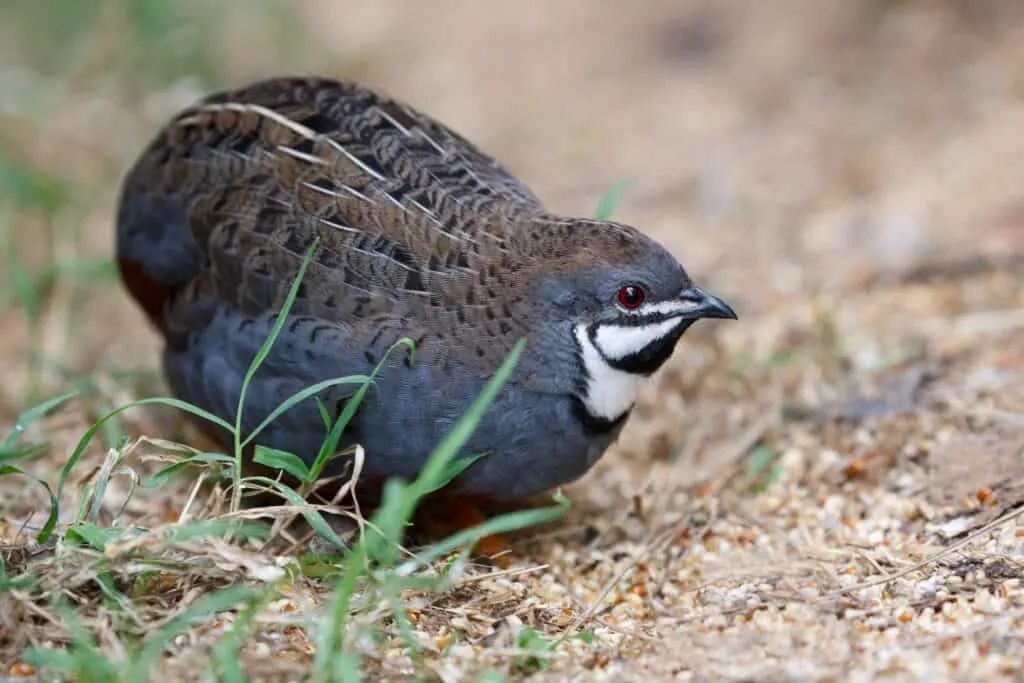
Kurrichane Buttonquail – Turnix sylvaticus. Range = Africa and Europe. Status = not threatened.
Little Buttonquail – Turnix velox. Range = Australia. Status = not endangered.
Madagascar Buttonquail – Turnix nigricollis. Range = Madagascar. Status = not threatened.
New Caledonian Buttonquail – Turnix novaecaledoniae. Range = New Caledonia. Status = severely endangered or possibly extinct.
Painted Buttonquail – Turnix varius (formerly Turnix varia). Range = Australia. Status = vulnerable.
Quail-plover – Ortyxelos meiffrenii, also known as Lark Buttonquail. Range = Africa. Status = not threatened.
Red-backed Buttonquail – Turnix maculosus. Range = Australia. Status = vulnerable.
Red-chested Buttonquail – Turnix pyrrhothorax. Range = Australia. Status = not threatened.
Small Buttonquail – Turnix sylvaticus. Range = India. Status = not threatened.
Spotted Buttonquail – Turnix ocellatus. Range = Philippines. Status = not threatened.
Sumba Buttonquail – Turnix everetti. Range = Indonesia. Status = threatened.
Worcester’s Buttonquail – Turnix worcesteri. Range = Indonesia. Status = was believed to be extinct until recent sightings on the island of Luzon.
Yellow-legged Buttonquail – Turnix tanki. Range = India, Manchuria, Taiwan, Hainan. Status = insufficient data.
So we move on to the most commonly kept type of Button Quail as pets, the:
Chinese Blue Painted Quail – Coturnix chinensis. Also called the Blue Breasted Quail or King Quail and commonly just referred to as Button Quail. However, this is not a true Buttonquail but is part of the regular quail family.
Range Australia, Borneo, Celebes, China, Flores, Hainan Island, India, Java, Lombok, Madagascar, Myanmar, New Guinea, Nicobar Islands, Philippines, Sarawak, Sri Lanka, Sumatra, Sumba, Taiwan, Thailand, Timor Islands, Vietnam.
Status: The exact numbers of these birds are unknown, but they are not considered to be threatened.
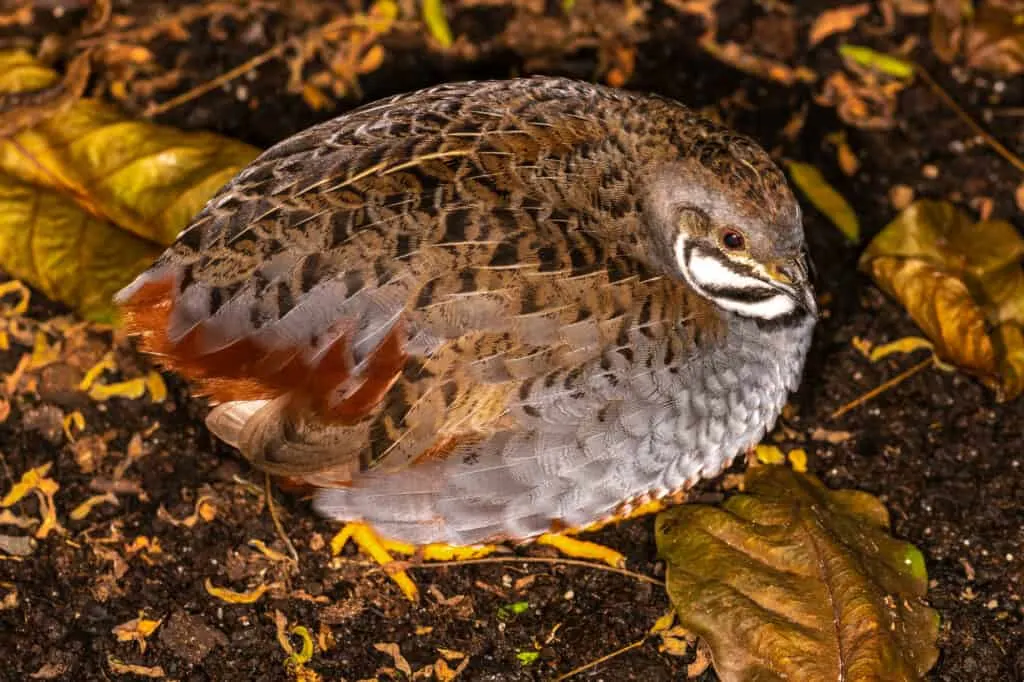
Temperament and Behavior
Button quail are very shy and can be difficult to tame if they are not hand-reared. If you are prepared to spend time with them while they are young, they can become relatively tame after a while.
They are not suitable as pet quail for children as they are pretty delicate and don’t like being handled. For the same reason, they may not be entirely suitable for beginners either as they take quite a lot of careful care and handling.
Untamed Coturnix Button Quail can be pretty skittish and will try to run and hide whenever possible. Unfortunately, this can result in them becoming injured quite easily and can even result in the bird’s death. It’s essential to provide plenty of hiding places in the environment you give them.
Coturnix Button Quail are not typically broody, and it can be challenging to get a hen to raise a clutch of eggs. Generally, you will need to use an incubator to hatch eggs out, and a brooder to raise chicks.
Coturnix Button Quail are generally quite solitary birds in the wild, usually living in a male, female pair. It is possible to keep several hens together with a single cock bird, but keeping more than one cock in an enclosure can lead to fighting, especially during the breeding season. If you wish to keep a breeding colony, choose a large pen with several hens to each cock bird to reduce fighting.
The quail will communicate using various calls meaning “hey I’ve got food” or “I’m looking for a female to mate with” are often witnessed. Both hens and cock birds crow, and this can be a single note, a three-note, or a four-note sound. Only the male button quail produce loud bellowing calls. None of the sounds are particularly unpleasant and can be rather lovely to hear.
Hens will make faint peeping noises to her chicks to keep in contact with them. But hens don’t usually chat among themselves like some chickens do.
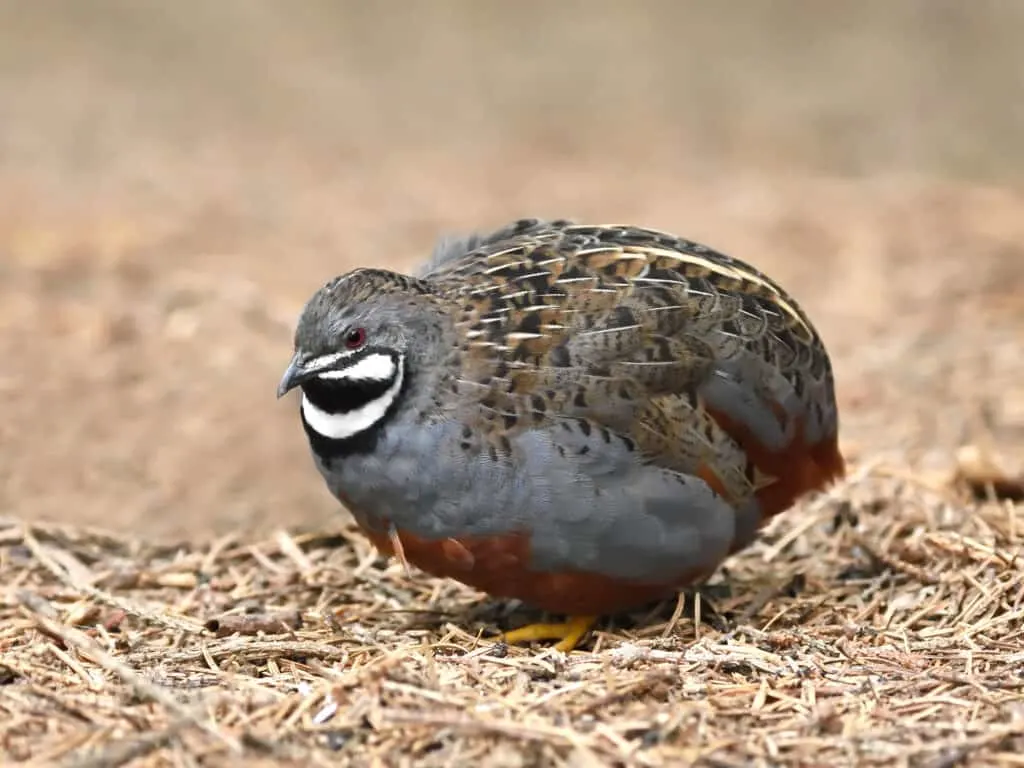
Breed Specifics and Traits
Button Quail are too small to be used for meat or eggs. They are generally raised as ornamental pet birds and can help clear up some of the grain spilled by the other birds in your aviary.
Adult button quail ranges from around 5 to 5 1/2 inches in length and weighing 1 to 1 ½ ounces.
The average lifespan for captive birds depends on many factors, including diet, environment, and level of care. On average it ranges from between 2 to 5 years.
Appearance and Colors of Button Quail (Coturnix)
Button quail are a small bird that’s rounded in appearance. Both males and females have bay colored eyes, black beaks, yellow legs and feet, and short, dark brown tails.
There are now a vast range of Button Quail colors available other than the original wild. Wild type Button Quail Males are dark brown with a slate blue/gray breast. Their belly can range in color from chestnut-red to dark rust. The throat has a black patch, and below it is a white band with a black border. A white teardrop shape runs from the beak down the neck, with a black edge. The back and tail feathers are mottled brown and black. Female quail are dark brown with pale silver breast. Their back and tail feathers are mottled brown and black.
Other common colors available include:
- Silver
- White
- Red-Breasted
- Blue Faced
- Cinnamon
- Golden Pearl
More unusual mixes and variations are:
- Blue Faced Cinnamon / Blue Faced Fawn – Cinnamon X Bluefaced genes
- Blue Faced Pearl – Blue Faced X Golden Pearl
- Cinnamon Pearl – Cinnamon X Golden Pearl
- Cinnamon Red Breast – Red Breast X Cinnamon
- Fawn – this name is given to dark cinnamon birds
- Ivory – Silver X Cinnamon
- Silver Pearl – Silver X Golden Pearl
- Silver Red-Breasted – Silver X Red Breasted
- Slate – Silver X Blue-Faced
- Smoky – Ivory X Blue Face
- Splash – Any of the primary colors with increased white spots
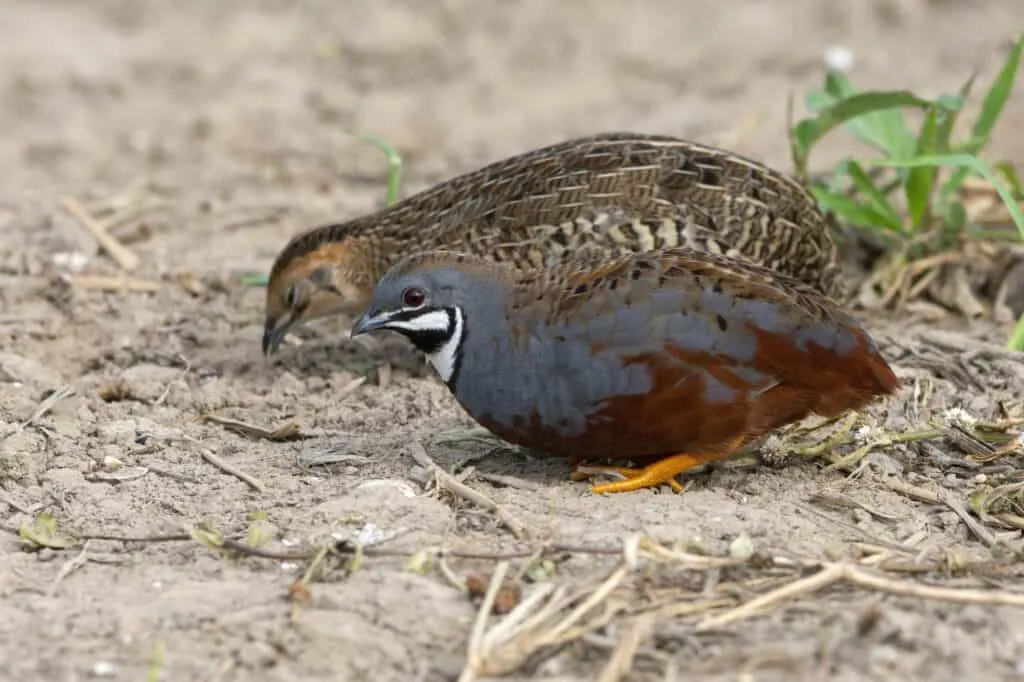
True Buttonquail species have some unique traits, including only three toes and no crop. Some have developed a unique vocal organ formed by part of their trachea combined with an inflatable bulb in the esophagus. The organ is capable of producing a loud booming call.
Chinese Blue Breasted Quail have four toes and a crop just like other regular quail types.
The hen is usually larger and of a duller color than the male Coturnix birds. This is not always the case in true turnix/ortyxelos Button Quails, where the females can often be the most dominant in all respects.
Both coturnix and turnix/ortyxelos quail are relatively heat tolerant, coming from parts of the world where temperatures can become high during the summer months. They don’t fare so well in cold weather and should be kept dry and away from drafts.
Quails are relatively predator resistant due to their ground-dwelling nature and ability to blend in well with their surroundings. They don’t typically fly and prefer to run along the ground and squat down when sensing danger.
When they are pressed to take flight, they only fly for short distances and at a low level with rapid wing beats.
Button Quail Health and Diseases
Quails are not especially disease resistant and can easily catch viruses from other birds, including chickens. Infectious coryza is one particular virus that is often passed on from your flock of hens and will wipe out your quail rapidly.
Viruses can also be spread through rodents entering your quail’s enclosure, so ensure it is durable enough to keep them out.
Not only can Button Quail catch disease, but they can be infectious disease carriers as well. Chlamydiosis can be spread from birds to humans and may be particularly dangerous to people with compromised immune systems, children under five, and pregnant women.
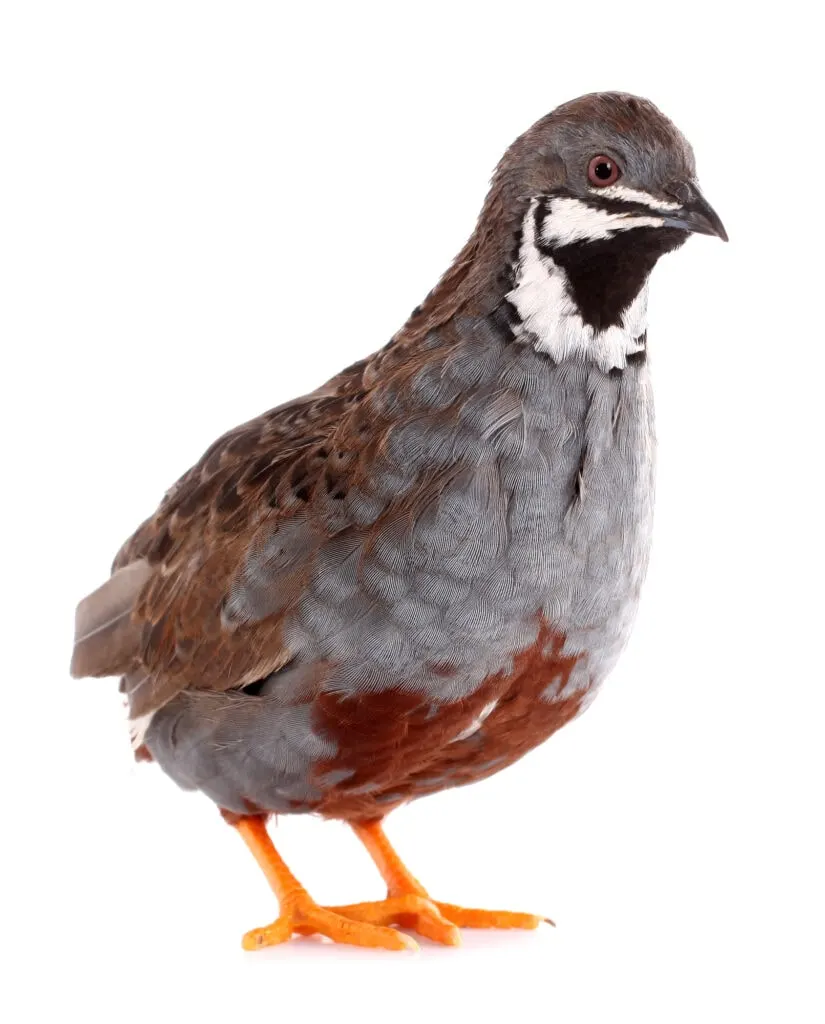
Raising Button Quail
The best kind of enclosure for keeping Button Quail is a large cage raised off the floor. They need to be provided with plenty of hiding places and leaf litter, and require access to constant food and water supplies.
Containers for food and water must be kept clean and need to be an inch from the ground to help with contamination by feces.
The enclosure should be easy to clean, and rodent, bird, and predator-proof. Position it so that it receives plenty of light and stays at as constant a temperature as possible. Quail don’t like significant fluctuations in heat and cold. They also need to be kept dry and away from drafts.
Clean the enclosure thoroughly once a week or more. Be careful using chemical cleaning products as they can irritate the bird’s lungs. Rinse any products you use away thoroughly.
Button Quail eat a variety of seeds, including millet, rape, maw, and niger. They also enjoy fresh greens and vegetation. Mealworms and other insects are eaten in small amounts.
When females are laying eggs, they will need to be given calcium which can be provided by feeding ground-up oyster shells or cuttlefish mantle available from your pet store.
Grit of a suitable size is also needed for them to digest the food correctly.
Button Quail Eggs and Young
Breeders usually use an incubator to hatch out their button quail eggs, as button quail hens tend not to brood naturally. They also lay their eggs all around the aviary rather than in one place. If broody, they will roll them into a nest.
If you do get a broody hen, she will usually lay between 8 and 10 eggs. Once her clutch is complete, she will incubate them for around 14 to 19 days before they hatch.
The baby button quail are tiny, about the size of your little fingertip. They have a brown or yellow coloration and grow incredibly rapidly, being utterly independent by around four weeks of age.
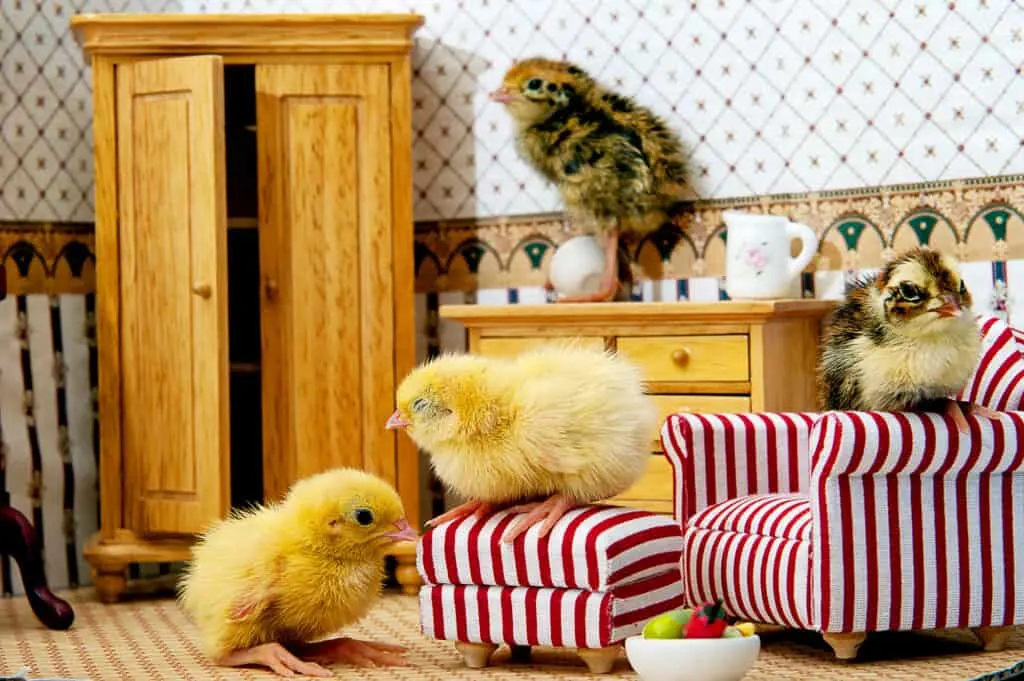
Due to the chicks being so small, you’ll need to wrap your aviary in something to ensure the tiny quail cannot escape, as they are incredibly vulnerable and will quickly be picked off by predators.
Chicks are also prone to drowning. To prevent this, fill a shallow water bowl with stones or marbles so they can’t become submerged in the water.
Like a chicken, button quail don’t feed their young but will teach them how to search for food and to peck.
You can feed the hatchlings with mashed hard boiled eggs and seeds or grains that have been ground into a powder with a coffee grinder. Add a little water to reduce dust. Adding some chopped mealworms is also a good protein source.
Some fresh greens in the form of romaine lettuce, dandelions, carrot tops, or chickweed that have been finely chopped are also welcome. Don’t forget about grit for digestion and oyster shells or cuttlefish for calcium.
As they grow, you can move them onto a small-grained mix for finches until they are large enough to eat the same as the adult birds.
You will need to separate your chicks from their Fathers before they reach maturity, as fighting can occur between males. Overcrowding will result in aggression between both sexes.
Young birds have two rapid molts and are fully grown by the age of six or seven weeks. They are sexually mature in under three months.
Button Quail lay between 6 and 21 small eggs per season. They are cream, olive green, pale green, mauve, or brown with dark speckles or mottling all over.
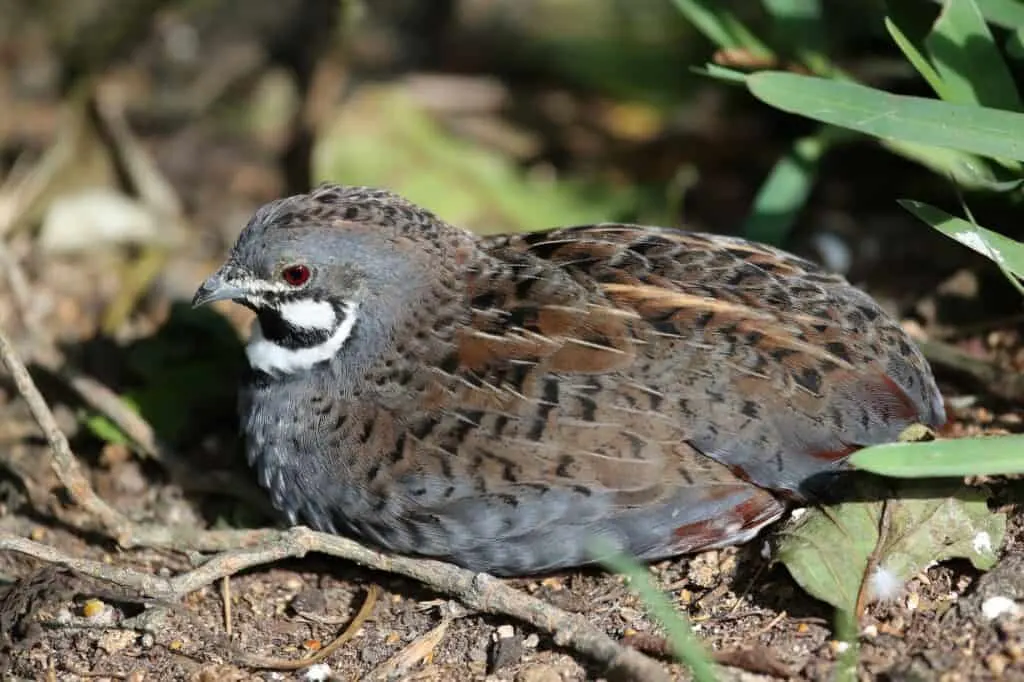
Where to Buy Button Quail
You can purchase Button Quail hatching egg packs online. Buying Button Quail chicks is difficult as they are so small and delicate most breeders don’t sell them.
Websites like PoultryFinder.com can help you find button quail breeders near you, or those willing to ship.
Summary
If you’re looking for small, ornamental, ground-dwelling birds to complement your aviary, then Button Quail may be the perfect solution. They are relatively hardy once acclimatized to their surroundings and require little by way of special care.
A bonus is they will eat much of the dropped seed and don’t interfere with your other birds.
If you’ve enjoyed learning a little about Button Quail, you’ll probably enjoy reading some of our other articles about quail and other birds.
Button Quail Overview
| Breed Name | Button Quail (Coturnix Chinensis) |
| Type | Ornamental |
| Size | Small |
| Heritage Breed | No |
| Average Weight | 0.99 ounce to 1.41 ounces |
| Weeks To Maturity | 4 weeks |
| Average Life Span | 2 to 5 years |
| Color variations | Wild Silver White Red Breasted Blue Faced Cinnamon Golden Pearl Blue Faced Cinnamon Blue Faced Fawn Blue Faced Pearl Cinnamon Pearl Cinnamon Red Breast Fawn Ivory Silver Pearl Silver Red Breasted Slate Smoky Splash |
| Egg Size | Small |
| Egg Color | Cream, brown, Green, Mauve with dark brown spots, speckles or patches |
| Egg Production | 6 to 21 per season |
| Dual Purpose | No |
| Temperament | Flighty |
| Beginner Friendly | No |
| Kid Friendly | No |
| Heat Tolerant | Average |
| Cold Tolerant | Yes |
| Comb Type | Single |
| Broodiness | Relatively |
| Flightiness | Not flighty |
| Noise Level | Medium |
| Unique Traits | Bearded, five toes, feathered legs |

Berin Castleman
Friday 28th of October 2022
I had my first quail chick hatch this morning from under the hen not incubator so cute out of six eggs hopefully the others hatch an the little one survives. I have 3 hens an 1 male but he didn't look to good this morning for some reason not sure what's wrong with him either will wait an see if he lives. Any more advice wud be appreciated thankyou.
Julie Kautz
Tuesday 24th of May 2022
I have had a female button quail for 7-8 years. She has always in a cage with other birds. Hoping to get a male soon. Love to hear the different sounds She makes. She even answers me when I call her name